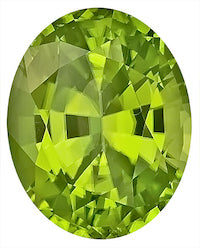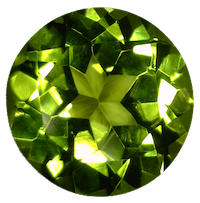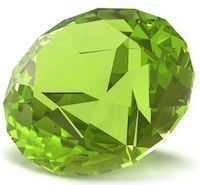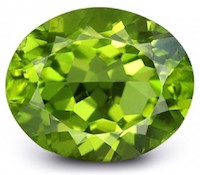How is Peridot Valued?
TABLE OF CONTENTS
What is Peridot?
Peridot is a brightly colored, yellow-green gem that's been prized since the age of the Ancient Egyptians. The stone is naturally formed in lava flows around the world, and is composed of the mineral olivine. Some rare and valuable forms of this gem can also be found inside of meteorites.
Peridot Chemical Makeup and Origin
Olivine is rich in magnesium and iron, which contribute to the stone's bright color. Peridot is found primarily in China, Vietnam, Myanmar, Egypt and the USA. The gem is relatively hard and scores a 7 on the Mohs hardness scale. Additionally, it scores between a 1.65-1.69 on the refractive scale.
Moreover, peridot is a beautiful stone that works wonderfully in a variety of jewelry such as peridot rings and peridot necklaces. It is also the gem that traditionally represents the 15th wedding anniversary, making it a great gift for a special celebration. The gem also represents light, and is often called the extreme gem due to its unique means of formation.
Varieties of Peridot
There are several varieties of peridot, each with their own special look and value. Below is a description of the most prominent varieties of peridot:
Burmese Peridot
As suggested by the name, this variety is found in Myanmar (formerly known as Burma). The stone is known for its availability in large carat cuts.

Green Peridot
Green peridot is the generic name for most types of the gem. Though it is sometimes confused with emeralds due to its vibrant green hue. When it comes to peridot versus emerald, remember that this gem differs from the latter in composition, looks, and price. Emerald is a darker color green and is also a rarer stone.

Hebei Peridot
The Hebei variety hails from a province in China of the same name. This variety has a distinctive chartreuse color with strong yellow undertones, which helps differentiate it from other varieties of the gem.
Changbai Peridot
Mined in the Changbai province of China, this variety is considered to be the most valuable, and of the finest quality. The gem is a brightly colored green and makes a beautiful addition to many pieces of jewelry.

Vietnamese Peridot
Vietnam is one of the major sources of peridot worldwide, and gems from here is an extremely popular choice. Vietnamese peridot was discovered in the 1990s and has risen to prominence in the market as the region produces peridot in a variety of shades of green.

What Affects Peridot Pricing?
Color:
Peridot stones are known for its bright, vibrant, green hue, and its color grade plays a major role in the gem's value. Unlike some gems such as diamonds, the number of inclusions is not the main factor in the color grade. Instead, the richness of the color, which is garnered by its hue, saturation, and tone, is more important.
Generally, the more saturated the color, the more valued the gem will be, as saturated color means that inclusions are less visible. Peridot with a brownish tint is considered low quality and should be avoided.
Carat:
As with any gemstone, an important determining aspect of peridot value is the carat/size of the gem. The gem's color is at its best when in stones that are 10 carats or more, further increasing the value of larger stones.
Cut:
Gemstones can be cut in many different styles depending on the type of jewelry it will be used for. Peridot cuts include round, cushion, oval, princess, emerald, and pear. The two most popular styles are round and emerald, which work well with the stone's delicate crystal structure. In terms of ring styles the most popular styles of peridot rings are solitaire, halo, and three-stone, all of which can be purchased at With Clarity.

Production & Mining:
Natural Peridot vs Natural Treated Peridot
A major factor in determining the worth and value of this yellowish-green gem is how it is produced and mined. Natural varieties are the most rare and the most expensive, and high-quality natural peridot can be difficult to find. Therefore a great deal of this gem goes through heat treatment, which is an 100% natural way to improve the color and clarity of the stone. Heat-treated peridot is still considered real, and often results in a higher quality, more beautiful result.
At With Clarity, many naturally mined gems are heat treated to attain the most stunning result. Some peridot can also be made in a lab. The result is a stone that is visibly identical to its natural counterpart, with the only difference being the origin of the stone. Gemstones made in labs are also chemically the same, and often results in better color and saturation.
Buying Peridot
The price of peridot is determined by the color grade, cut, and carat of the stone, as well as how the gem was produced. When purchasing peridot it is important to consider your personal budget as well as the look you are aiming to achieve.
On average, natural peridot costs between $50-$80 per carat, though some higher quality stones can cost significantly more. Lab created peridot is more affordable and costs up to 40% less per carat.
FAQs
What color is peridot?
How much is peridot worth?
Does peridot make for a good engagement ring?









